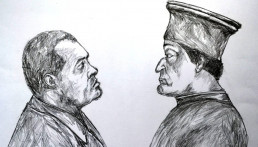
Symbiosis of a look
“Reflection” comes from Latin reflectere, reflect. Its meanings are:
– Light effect produced by the reflection of light on the body.
– Nuance appearing on a colored background, varying according to the lighting.
– Image that reflects a reflective surface.
– Nobody or thing that reproduces the main features of another.
– Radiance emanating from something and appearing in another [1].
From the different meanings of the word, I wanted to represent this one: “Person who reproduces the main features of another”. More specifically, through their eyes. These two characters, with their distinct interiority, appear as a reflection of the society in which they were born.
On one side, Frederick of Montefeltro, Duke of Urbino and Prince of the Renaissance. Having lost an eye during a tournament, he liked to take a portrait of the side of the eye healthy. Daniel Arasse’s description of the studiolo of his ducal palace of Urbino speaks volumes about the character. A coffered ceiling, and illusionist inlays exhibit a seemingly neglected, secretly controlled decor. The figure of the Duke, although present, has a place behind the scenes, which makes of the place the place of the meditation of the power of the prince [2].
On the other side, I represented an American prisoner of the present day. Taken in profile in front of the traditional rule measuring his height, his eyes are hard, his brows frown and his mouth slightly pinched. Nevertheless haughty, proud, he does not seem to regret his delinquent acts.
And if these two characters of a life so distant were the reflection of each other? Reflection of a society where birth determines the class, the social environment, the possibilities of education, and somewhere the actions of the individual. But an anomaly, a contradiction emerges from the painting. This is the link that unites them: they are in symbiosis. If “the eye is hugged” [3], the duke and the delinquent are united by their human nature. If they seem to challenge each other, their heads come together, it’s the embrace before the fight.
The idea of life is also subjacent. Petrarch, in his correspondences as in his poems, refers to the painted portrait that is about to speak, which is alive, “he only lacks the voice”. This definition is common to the Renaissance. In these Vite, Vasari evokes this notion of living portrait when he tries to praise portrait painters. As with Masaccio: “Such a power of truth that only the word seems to miss”. About The Mona Lisa: “Wonderful thing that could not be more alive.” It is a common place from Antiquity to the Renaissance: the portrait has the function of making present the absent, allowing the living to see the dead.
The two drawings are plastically treated in the same way, which gives a certain coherence and symmetry to the whole. The texture of the painting is nevertheless different. The left side is rough, irregular. Like the life of this man. The right side, smooth, immaculate (at least in appearance). Their lower part is unfinished, bringing attention to their bodies and leading ports.
Issues addressed: Questioning the reflection of the gaze.
Concepts addressed:
– Violence of looks / clash
– Favored social class / failing class
– Life / death
– Drawing / painting
– Line / area
– Figuration / abstraction
– Materiality / immateriality
– Hardness / fragility
Reference field:
– Portrait of Frederick of Montefeltro in a painting by Piero della Francesca (1470-1473)
– The fight for the memory of Ernest Pignon-Ernest
– Cy Twombly and his mix of styles
– The matter and Anselm Kiefer
– Failure as the engine of creation, Giacometti
– The late Daniel Arasse for his writings
[1] Larousse Dictionary.
[2] Daniel Arasse, The subject in the painting, “Frédéric in his cabinet”. Ed Flammarion, 2005.
[3] The psychoanalysts designate as scopic impulse the charge of sexuality that bears the gaze of voyeurism / exhibitionism.
SchoolThird year work in the visual arts, University Paris 1 Panthéon-SorbonneMaterialsGraphite and acrylic paintYear2017


